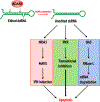The role of RNA editing enzyme ADAR1 in human disease
- PMID: 34105255
- PMCID: PMC8651834
- DOI: 10.1002/wrna.1665
The role of RNA editing enzyme ADAR1 in human disease
Abstract
Adenosine deaminase acting on RNA (ADAR) catalyzes the posttranscriptional conversion of adenosine to inosine in double-stranded RNA (dsRNA), which can lead to the creation of missense mutations in coding sequences. Recent studies show that editing-dependent functions of ADAR1 protect dsRNA from dsRNA-sensing molecules and inhibit innate immunity and the interferon-mediated response. Deficiency in these ADAR1 functions underlie the pathogenesis of autoinflammatory diseases such as the type I interferonopathies Aicardi-Goutieres syndrome and dyschromatosis symmetrica hereditaria. ADAR1-mediated editing of endogenous coding and noncoding RNA as well as ADAR1 editing-independent interactions with DICER can also have oncogenic or tumor suppressive effects that affect tumor proliferation, invasion, and response to immunotherapy. The combination of proviral and antiviral roles played by ADAR1 in repressing the interferon response and editing viral RNAs alters viral morphogenesis and cell susceptibility to infection. This review analyzes the structure and function of ADAR1 with a focus on its position in human disease pathways and the mechanisms of its disease-associated effects. This article is categorized under: RNA in Disease and Development > RNA in Disease RNA Processing > RNA Editing and Modification RNA Interactions with Proteins and Other Molecules > Protein-RNA Interactions: Functional Implications.
Keywords: ADAR1; AGS; RNA editing; human disease; innate immunity.
© 2021 Wiley Periodicals LLC.
Conflict of interest statement
CONFLICT OF INTEREST
The authors have declared no conflicts of interest for this article..
Figures






References
FURTHER READING
Publication types
MeSH terms
Substances
Grants and funding
LinkOut - more resources
Full Text Sources
Other Literature Sources
Medical
Research Materials

